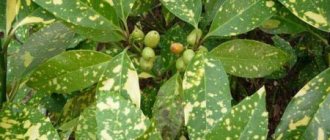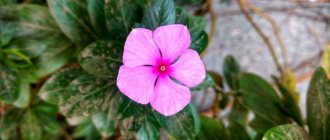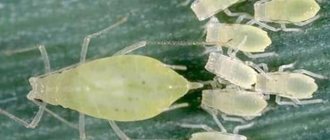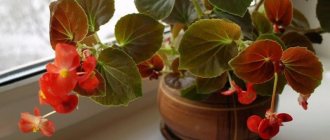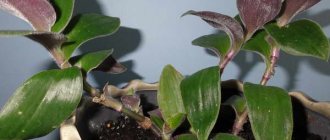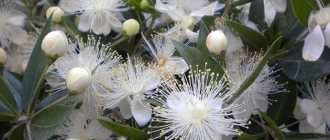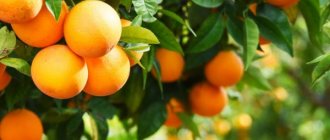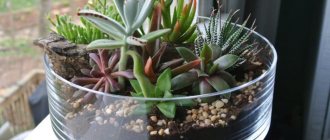Among the profusely flowering indoor plants, pigweed, or Plumbago, has always occupied a special place. This is one of the most romantic large plants you can imagine. Beautiful flowers, collected in loose inflorescences and covering dense bushes, seem like lacy foam from afar. Pigweed looks messy and festive at the same time; this plant, which creates a special mood, is not for everyone. Feminine and touching, pigweed is a culture with a difficult character that loves high air humidity and requires careful care.
Ear-shaped or cape pigweed (Plumbago auriculata). © Evaldo HS Nascimento
Description of the piglet, or plumbago
The botanical name of the pigweed is plumbago. The plant belongs to the pigweed family. The perennial evergreen shrub can reach 1 m in length, but the bush still remains compact, because the plant grows in the form of a vine.
Plumbago, or plumbago, will be a wonderful decoration for the loggia
Origin story
Plumbago is a lush and bushy plant with small foliage. The length of the leaf blades is no more than 9 cm. The leaves have an elliptical shape and a bright and rich green color; they are located on short petioles.
No trimming
This plant blooms only on young growth; the shoots themselves hardly branch, but they willingly stretch out and become bare, produce leaves and bloom at the tops. And even formed bushes still fall apart and scatter, requiring a lot of space. Without annual pruning at the end of February or beginning of March, good flowering cannot be achieved. Sometimes the plant is pruned in the fall to make it compact, but this weakens the plant. First, it is worth carrying out sanitary cleaning, removing unproductive, damaged shoots, and then stimulating the growth of new branches.
There is no need to be afraid of heavy pruning. Shoots can be shortened to “stumps” of 15-30 cm, the standard is leaving about a third of the length and at least 2-3 internodes. If the vine is compact or they want to preserve the natural shape of the vine, simply pinch and shorten the tops. For young, unformed bushes, it is advisable to immediately create a base with 3 to 4 skeletal shoots. As it grows, it is better to fix it on a support (arc, circle, ladder), carefully bending and entwining the shoots. Usually, the lead reacts to twisting with very rapid growth. If desired, you can form a standard and strict round contours.
If the stem is sick, does not bloom, or stretches out, you can use stimulating pruning throughout the season, shortening the shoots to “launch” new growth.
As the lead grows, it is better to secure it to a support.
Varieties of indoor plants with names
How ampelous lobelia blooms - white, blue, blue
In indoor conditions, blue and auricular guinea pigs are most often grown, but in nature there are many other interesting varieties.
- Blue auricle. Can grow up to 5 m in length. It has very branched long shoots, on which there are smooth and shiny leaves 5 cm long. The leaf blades are light, sometimes yellowish. Small flowers of white and bluish shades with round petals.
- Red or pink Indian pigweed. The Indian variety is sometimes called red pigtail. It is a branched shrub with wide, green, glossy leaf blades that have jagged edges. The pigweed has red flowers collected in inflorescences-spikes.
- Ceylon pigweed. The plant looks like the auricular variety but has snow-white flowers. Famous for its healing properties.
Landing
The plant will feel great if you place it on the lightest windowsill, the windows of which face south or any partially southerly direction. On the western side the amount of light will be insufficient, and on the east the leaves can sometimes get burned. In principle, direct sunlight is not dangerous for pigs. An exception may be the situation when the flower is exposed to the midday sun, but is not ventilated.
If diffused lighting remains throughout most of the day, and direct rays partially fall in the morning and evening, then the pigweed will feel great and delight the owners with beautiful flowering.
During the growing season and flowering, artificial lamps are not required for pigweed, but in winter it is wise to place phytolamps next to the pots to normalize the length of daylight hours. Otherwise, the shoots will begin to stretch out unsightly, and a sufficient portion of the leaves will fall off. Pineweed feels normal next to other vines or smaller flowers. The plant does not respond well to heat
If, for natural reasons, the temperature exceeds 22-23 degrees, then it will be important to greatly increase the humidity level, as well as ensure a constant flow of fresh air
It is better to choose a substrate that is permeable and rich in useful elements. Pigweed responds well to slightly acidic soil containing a sufficient amount of peat. You can purchase a ready-made soil mixture intended for flowering plants, or you can make it yourself. In the second case, 2 parts of turf, 1 part of peat and 1 part of sand are used.
New pigweed bushes appear either from seeds or by cuttings. The seed is sown in a moistened soil mixture made up of sand and regular soil. The container should be covered with polyethylene or a glass sheet to create greenhouse conditions and maintain the temperature at 20 degrees. As soon as full-fledged leaves appear on the sprouts, you can begin picking into separate pots.
For cuttings, branches remaining after spring pruning are most often used. After treating the cuttings with growth stimulants, they need to be buried in moistened sand. If the stem is covered with a dome made from half a plastic bottle and provided with a temperature of 16 degrees Celsius and stable humidity, then the roots will appear in about a couple of weeks. Some gardeners recommend additional heating from below, under the pot, for example, by placing flowerpots directly on the radiator. Flowering of the pigweed can be expected as early as next year.
It is more convenient to plant plumbago in hanging pots or flowerpots. Since the stems will begin to grow over time, it is necessary to think about how they can be fixed. In an apartment it is more convenient to put shoots on the cornice, but on a loggia you will have to use some additional hooks on the wall. If the pig develops in outdoor conditions, then columns, poles, and railings are suitable.
Caring for blue piglet at home
Blue agave - what is it?
The pig is not very capricious in care, but you should not forget about the necessary and regular measures: pruning, watering, pest prevention, fertilizing.
Proper care promotes healthy growth
Illumination and temperature conditions
Good lighting is necessary for abundant flowering. But on hot sunny days it is recommended to shade the flower with something or move it to a more shaded place. In winter, there is no need for additional lighting, since the plant is dormant and should be kept away from the sun.
During the active period, the temperature of the flower should be within 17-15 °C. When the pig leaves for a period of rest, the temperature is reduced to 10 °C.
Important! During wintering, the temperature cannot be lowered below 5 °C, otherwise the plant will become hypothermic.
Watering rules and humidity
It is necessary to water the flower often, the main thing is not to flood it. The soil should be constantly moist and loose. During the dormant period, watering is gradually reduced.
Humidity levels should be above average, about 60-70%. If the air has become drier, use special humidifiers or cope with traditional methods. Additional moisture is provided by spraying with water.
Important! When spraying, do not spray onto the buds.
Fertilizing and soil quality
Plumbago needs to be fed twice a month with mineral and organic supplements. It is better to choose water-soluble potash. They help the buds bloom abundantly. After the flower leaves for the dormant period, feeding is stopped and resumed only in the spring.
Pigwort is a plant that requires well-drained soil with good air permeability. The substrate for planting should consist of more than just soil. Moreover, the soil should be loose and moist without a high level of acidity.
Note! The soil is mixed with heather substrate, compost, peat and rotted manure.
Flower container size
The planting container should be wide, but not very deep. For replanting, use pots 2-3 cm larger in diameter and depth than the previous one.
Pruning and replanting
When growing plumbago at home, it is necessary to trim the tips of new shoots. This is done to obtain a thicker and more luxuriant plant and to direct all the energy to flowering.
Note! In addition to traditional pruning, you need to constantly remove wilted stems and leaves.
In the first years, transplantation is carried out annually. In subsequent ones, only the top layer of soil is changed.
Drastic changes
Pigweed is not a stress-resistant plant. She does not like not only temperature fluctuations, cold drafts, moving, sudden movements, but also any contrasts. Even watering for it is better to reduce slowly, and fertilizing should be introduced in the spring and stopped gradually. And if possible, gradually lower and raise the temperature, accustom the bushes to the spring sun.
All sudden changes will inevitably affect flowering. And they can either delay it or cancel it if the stress is too strong.
Did you like the article? Share with your friends and like!
Facebook Twitter VKontakte
NEWS DELIVERY BY MAIL IS CONVENIENT
When you subscribe, you will receive an email about new articles posted on the site over the past two weeks.
Features of plant flowering
Camellia flower - Japanese, red, Chinese white
The plant blooms long and profusely and a pleasant and delicate aroma spreads from its buds.
Blooming plumbago is accompanied by a pleasant aroma
Period of activity and rest
The period of activity of the plant coincides with its long flowering. The buds begin to bloom in early spring and continue until autumn. In winter, the flower goes into short rest, no more than two months.
Types and shape of flowers
Plumbago flowers are collected in dense umbrella inflorescences. Each has about 20 small pale blue flowers. The buds have a long tube and 5 round petals with a diameter of about 2 cm.
Regulating irrigation frequency using soil composition
Properly prepared soil is an important tool that allows you to create an optimal moisture regime for the roots of the plant. It is better to avoid planting on pure peat. It is very difficult to control the humidity of a peat substrate - it either gets too dry and then does not allow water to pass through well, or it becomes waterlogged and turns into a swamp. On this type of soil, plumbago can only be grown with drip irrigation.
The practice of growing pigweed shows that the optimal soil mixture for these plants is obtained from the following components:
- turf soil - 3 parts;
- leaf humus - 1 part;
- universal peat soil - 2 parts;
- perlite – 1 part.
This mixture has good nutritional value, normally absorbs and retains moisture, practically without compacting after watering. On the other hand, it drains well, and if the pot has bottom holes, such soil does not become waterlogged or waterlogged.
- In its pure form, poorly structured peat-based soils are unsuitable for long-term cultivation of plants. They definitely need to be improved by adding other components.
Growing problems, diseases and pests
The pig rarely gets sick, but often suffers from attacks by pests. Among the parasites that are especially dangerous are:
- whitefly Its attack is indicated by small white dots on leaf blades and shoots. Provokes yellowing of the bush and falling of leaves and buds;
- mealyworm, which is located on the leaves and covers them with a brown coating. Due to the pest, the piglet begins to wither and normal development stops;
- spider mite, which is almost invisible on the bush. It provokes yellowing and falling of the foliage, which also begins to become covered with cracks.
Pests can cause great harm to the bush
Note! Plumbago most often suffers from improper care. Excessive watering, lack of fertilizing, and lack of lighting affect the healthy growth of the bush.
When fighting parasites, effective drugs are needed - insecticides. The whitefly is destroyed by actellik, commander, and karbafos. Traditional methods often use a warm shower with soapy water. The same method helps cure a bush from mealybugs. To destroy spider mites, it is necessary to irradiate the bush with an ultraviolet lamp and treat it with phytoverm.
Svinchatka is a beautiful hanging plant that decorates the interior of the house. In summer, containers with flowers can be taken out into the garden. The plant needs careful care to prevent the appearance of pests or diseases.
Blanket 220x200 cm
999 ₽ More details
Blanket 220x200 cm
999 ₽ More details
Dark sofas
Insufficient feeding
Pigweed is demanding on soil nutrition. If it lacks nutrients, you can’t count on it to bloom. This is especially dangerous for plants that have not been replanted this year.
Fertilizing begins with the resumption of growth and continues until it stops completely, using a standard dose of fertilizer for beautifully flowering plants (universal fertilizers are acceptable in early spring), every 2 weeks, in liquid form, combined with watering. When choosing a fertilizer, you should make sure that it contains microelements, in particular manganese, to the lack of which pigs are hypersensitive.
Reproduction methods
Propagation of Crassula by seeds
Sowing Crassula seeds must be carried out in wide bowls, which are filled with a substrate consisting of sand and leaf soil (1:2). The container is covered with glass on top, and condensation must be removed from it every day, and do not forget to ventilate the crops regularly. The first seedlings should appear after 15 days. After the seedlings have grown a little, they should be planted into a large container, keeping a distance of 10 mm between the bushes, and it should be filled with a substrate consisting of light turf and leaf soil and sand (1: 2: 1). After picking, the container with the plants is placed in a well-lit place, and the light should be bright and diffused. After the bushes have grown and become stronger, they should be picked into individual pots, which reach 50–70 mm in diameter, and they should be filled with a substrate that includes turf and leaf soil, as well as sand (1:1:1) . Until they take root, they should be kept at a temperature of 16 to 18 degrees, and then they are placed in a permanent place.
Propagation of Crassula by cuttings
Propagating Crassula by cuttings is much easier and faster than by seeds. Leaf plates and stem segments can be used as cuttings. A large leaf plate or large shoot must be cut with a very sharp knife, and the cut areas should be sprinkled with crushed charcoal. They need to be withered for 2–3 days, and then planted in a substrate consisting of leaf soil and sand for rooting. They can also be placed in water mixed with charcoal for rooting. After the cuttings grow roots, they should be planted in individual pots reaching 50–70 mm in diameter. To fill them, use a substrate consisting of turf and leaf soil, as well as sand (1:1:1). Then the bushes are removed to a permanent place, and they need the same care as adult plants.
REPRODUCTION OF A BEAUTIFUL PLANT - MONEY TREE FROM A TO Z! HOW TO PROPAGATE A MONEY TREE.
Watch this video on YouTube
Characteristics of culture
Plumbago, a flowering plant from the family Plumbago, is colloquially called plumbago, a derivative of the word “lead” (in Latin “plumbum”).
According to one assumption, it received its name because of its chemical properties - it is an antidote for lead vapor poisoning; according to another, the juice of the plant colors tissues in a bluish-blue, pale blue color, similar to the color of metal. Plants from the genus plumbago are herbaceous creeping or climbing shrubs, subshrubs from 0.5 to 3 m in height. Liana-like shoots are covered with spirally arranged elliptical short-petioled leaves up to 12 cm long and about 2 cm wide. The edge of the leaf, narrowed at the base, is entire, sometimes Hairy veins are clearly visible on the surface. Young leaves are green; in some varieties, the lower part becomes whitish with age.
The inflorescence, racemose or spike-shaped, is collected from large (2-3 cm in diameter) almost sessile flowers similar in appearance to a phlox flower, and is formed at the top of the shoot. A corolla of five rounded whitish-blue, white, pink, red petals with a central vein is located on a long (up to 5 cm) tubular calyx.
